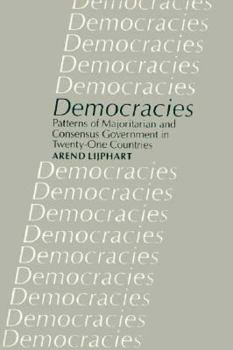Democracies: Patterns of Majoritarian and Consensus Government in Twenty-One Countries
Select Format
Select Condition 
Book Overview
There is more than one way to run a successful democracy. Lijphart divides these democracies into two basic models: majoritarian democracies, in which the majority rules, and consensus democracies, in... This description may be from another edition of this product.
Format:Paperback
Language:English
ISBN:0300031823
ISBN13:9780300031829
Release Date:September 1984
Publisher:Yale University Press
Length:232 Pages
Weight:0.70 lbs.
Dimensions:0.8" x 5.6" x 8.2"
Customer Reviews
1 rating
Systemic Analysis of Variation in Democratic Government
Published by Thriftbooks.com User , 17 years ago
Lijphart suggests that within the broad framework of democratic government, democratic states tend to cluster around two political subsystems: the majoritarian and consensus models. In examining these two subsystems, he illustrates the differences along two dimensions: (1) executive-parties; (2) federal-unitary. The executive-parties dimension includes variables like executive type, relations between executive and legislative bodies, party system and electoral system. The federal-unitary dimension contains the variables degree of government centralization, type of legislature, and the degree of flexibility within the constitutional context. In the remainder book, Lijphart takes a systematic approach in analyzing the differences between majoritarian and consensus democracy along his two dimensions. For example, along dimension one, the majoritarian system is characterized by a two-party system in which representatives are elected through a SMD electoral system. However, the actual differences between the parties are quite small, leading Lijphart to label the majoritarian model a "one dimensional party system." The majoritarian system is further characterized by a high concentration of executive power, controlled by one party and accompanied by bare majority cabinets. Because of the system of majority rule, the executive and cabinet is dominant in relation to the parliament. In comparison, consensus democracy is characterized by a multiple party system (more than two) and these parties are separated by a number of issue dimensions. Representatives are elected through a PR electoral system. Because of the multiparty system, majority rule isn't likely. As such, the executive branch is often composed of broad coalitions which may include minority parties. Minority rights are further protected by a bicameral legislature which grants special representation to smaller groups. Furthermore, unlike the majoritarian model, power is shared between the branches of government and not monopolized by the executive branch. Along the second dimension, the majoritarian system maintains a unitary and centralized government. This means the parliamentary majority can operate in any functional area. The majoritarian system is characterized by a distinct lack of federalism. Furthermore, the majoritarian system is often characterized by an unwritten constitution. As such, government powers "are defined instead in a number of laws, customs, and conventions." Additionally, there is a lack of judicial review which makes parliament the ultimate authority. The consensus model, however, is characterized by a system of federalism (both territorial and material) which grants degrees of autonomy to various groups. This leads to a rather decentralized system of governance. Additionally, most consensus democracies maintain a written constitution. This makes changes difficult through minority veto, thus protecting minority rights. Lijphart then operat





